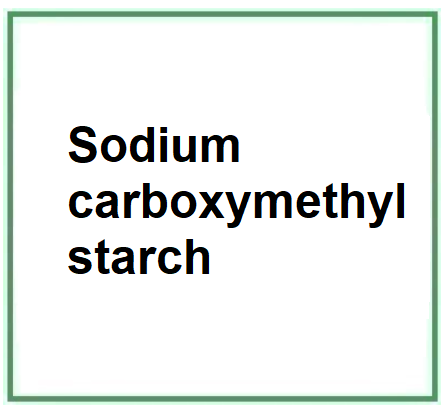Sodium carboxymethyl starch (Sodium CMS) is a plant polysaccharide, an important vegetable starch. Primarily extracted from maize which is modified by carboxymethyl to become etherified starch sodium salt (modified starch sodium salt), anionic. Resists amylase in vitro In the small intestine it is not hydrolyzed by D-glucose in the small intestine, but can be fermented in the colon by anaerobic bacteria (1).
Electrolyte soluble in cold water. Insoluble in ethanol, ether, chloroform and other organic solvents. In aqueous solution above 80°C there is a decrease in viscosity.
It is most commonly called in its abbreviated form CMS-Na.
Carboxymethyl starch ether was first produced in 1924 and as an industrial product in 1940.
Sodium carboxymethyl starch is a carboxymethyl derivative of starch. It is produced by reacting starch with chloroacetic acid, thus producing carboxymethylated starch, which is then neutralized with a sodium hydroxide solution.
Description of raw materials used in production.
- Starch. This can be derived from various plant sources like corn, potatoes, rice, or wheat.
- Chloroacetic acid. A derivative of acetic acid, it's used as the reagent to introduce the carboxymethyl group.
- Sodium hydroxide (caustic soda). Used to neutralize the chloroacetic acid and convert carboxymethylated starch into its sodium salt.
Step-by-step summary of its industrial chemical synthesis process.
- Starch is suspended in water and heated.
- Chloroacetic acid is added to the suspension, and the reaction is allowed to proceed.
- Once carboxymethylation is complete, the reaction is neutralized with sodium hydroxide, converting the carboxymethylated starch into its sodium salt.
- The product is then purified, filtered, and dried.
It comes in the form of a fine, white or slightly yellow powder It is not toxic, hardly attacked by mold if the degree of substitution is greater than 0.2,

Commercially it is a modified starch that is produced in two types: carboxymethyl starch (CMS) and pregelatinized starch. Depending on the raw materials used for preparation, it is marketed as pregelatinized corn starch and pregelatinized tapioca/cassava starch.
Sodium carboxymethyl starch studies
What it is used for
- Detergents and cleaners. It has the ability to improve suspension dispersion and prevents dirt particles or pollutants from entering the suspension.
- Construction. Stucco powder, waterproof wall stucco, cement plastering mortar, cement insulation cracking mortar, tile adhesives, drywall. In cement and gypsum processing, it is used with hydroxypropylmethylcellulose as a thickener, resists cracking, improves the workability of raw materials, and can reduce the content of hydroxypropylmethylcellulose.
- Paper. Has the function of sizing, coagulating to improve tear strength.
- Textile. Finishing agent, sizing agent.
- Petroleum. Has good rheological properties that improve stability, water retention, flow and liquid loss.
- Paints. Anti-suspension agent, emulsifying dispersant, filmogen, thickener and binder.
- Feed. Embedded in formula with carboxymethylcellulose and sodium alginate offers good compatibility with Xanthan gum.
- Pharmaceutical. It functions as a superdisintegrator for all solid oral dosage forms. It has an ability to swell up to 280 - 320 times its original granule volume. It is an excipient especially used for wet or dry granulation and direct compression and can be incorporated in intra- or extra-granular mode. or both. It generally has a potato starch base. It is produced in two types: Type A with low viscosity and low residual solvent and Type B particularly suitable in strongly acidic drug formulations to maintain stability and resist acidic pH.
- PVA. In some sectors it is a good substitute for polyvinyl alcohol.
- Medicine. Sodium carboxymethyl starch (CMS-Na), is a type of food additive with high degree of substitution and is also known as a prebiotic. This study finds that it can be used as an adjuvant in constipation (2).
Cosmetics
Binder agent. Ingredient that is used in cosmetic, food and pharmaceutical products as an anti-caking agent with the function of making the product in which it is incorporated silky, compact and homogenous. The binder, either natural such as mucilage, gums and starches or chemical, may be in the form of a powder or liquid.
Emulsion stabiliser. Emulsions are thermodynamically unstable. Emulsion stabilisers improve the formation and stability of single and double emulsions. as well as their shelf-life. It should be noted that in the structure-function relationship, the molar mass of the ingredient used plays an important role.
Film-forming agent. It produces, upon application, a very thin continuous film with an optimal balance of cohesion, adhesion and stickiness on skin, hair or nails to counteract or limit damage from external phenomena such as chemicals, UV rays and pollution.
Viscosity control agent. It controls and adapts, Increasing or decreasing, viscosity to the required level for optimal chemical and physical stability of the product and dosage in gels, suspensions, emulsions, solutions.
Typical optimal characteristics of the commercial product Sodium carboxyl methylstarch
| Appearance | Polvere bianca o giallastra fine |
| pH | 8-12 |
| Dry reduction | 10%-13% |
| Viscosity, mpa.s | 80-120 mPa.s |
| Purity% | 87-95 |
| Degree of substitution | ≥0.2 |
Where to buy
- Molecular Formula: [C6H7O2(OH)2OCH2COONa]n [C10H19O8Na]n
- Linear Formula (C2H4O3)x · (Na)x
- PMolecular Weight: 290.243
- Exact Mass 290.097748
- CAS: 9063-38-1
- UNII 5856J3G2A2
- EC Number: 1308068-626-2
- DSSTox Substance ID:
- MDL number MFCD00217761
- PubChem Substance ID
- InChI Key MOSFIJXAXDLOML-UHFFFAOYSA-N
- SMILES
- IUPAC
- ChEBI
Synonyms:
- CMS-Na
- Carboxymethyl starch sodium
- Sodium starch glycolate
- Sodium starch glycolate type B
- Sodium carboxyl methylstarch
- Sodium [(3R,4S,5R)-4,5-dihydroxy-6-methoxy-3-methyltetrahydro-2H-pyran-2-yl]methanolate - hydroxyacetic acid (1:1:1)
References______________________________________________________________
(1) Edwards CA, Xie C, Garcia AL. Dietary fibre and health in children and adolescents. Proc Nutr Soc. 2015 Aug;74(3):292-302. doi: 10.1017/S0029665115002335.
(2) Lu WD, Wu ML, Zhang JX, Huang TT, Du SS, Cao YX. The effect of sodium carboxymethyl starch with high degree of substitution on defecation. PLoS One. 2021 Sep 3;16(9):e0257012. doi: 10.1371/journal.pone.0257012.
![]() Sodium carboxymethyl starch
Sodium carboxymethyl starch 


